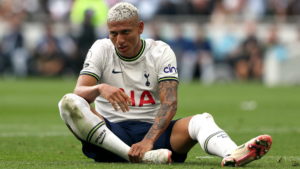Football players usually suffer one or more injuries while putting themselves on the line for our entertainment. Before rushing to your best football betting sites to place a wager, you should consider the possibility that some of the game’s stars will be injured and their performance will be significantly hampered. Although football players are frequently injured, some positions are more vulnerable to injury than others. Here is a list of player positions and the most common injuries they sustain.
Forward
The list begins with forwards, the bane of goalkeepers and defenders. Forwards are more likely to sustain injuries because they bear most of the team’s load. As a result of tussling with midfielders and defenders, they frequently suffer lower limb injuries such as knee sprains, foot fractures, calf strains, hamstrings, and ankle sprains.
They must also sprint long during a match and are susceptible to a muscle pull. It’s not uncommon for a forward to sustain shoulder and neck injuries because they’re viciously rough-handled by defenders whenever they get close to the goalposts.
Goalkeeper
The goalkeeper is an invaluable asset to any football team, serving as the last line of defence between the ball and the goal. Because goalkeepers are the only players permitted to handle the ball with their hands, they are prone to arm injuries such as finger dislocation and ligament tears.
Goalkeepers can also sustain non-contact injuries from sprints, dives, jumps, throws, and kicks. As a result, contusions, bruises, abrasions, fractures, and elbow wounds are unavoidable for goalkeepers. Furthermore, goalkeepers may collide with other players or be rammed into goalposts while launching a counter-attack or deflecting a ball.
Defenders
A defender’s primary duty is to stand between the goalie and the strikers as a protective barrier. Injuries are inevitable as an aftermath of the intense friction that forwards experience with one another. Defenders who brawl with forwards are frequently tackled and risk having their shoulders dislocated. Moreover, defenders block shots from strikers and often take significant blows to the shins. Forwards may sometimes tackle defenders, causing severe neck and shoulder injuries.
Midfielders
A midfielder is typically the player who travels the most distance during a match and is tasked with creating opportunities for forwards to score. They may also score themselves if an opportunity presents itself. With such a heavy load, midfielders are prone to common football injuries such as hamstring strains, so they should always stay fit to avoid them. Midfielders typically stress their pelvic area and may occasionally suffer from groin strains due to the massive distances they travel during a match. Sprains of the connective tissue between the thigh bone and the femur are also reasonably common.
In addition, as their knee joints age, midfielders are susceptible to meniscus injuries that, if untreated, can render them permanently out of commission. Due to their constant contact with players in various positions, midfielders frequently suffer from a condition known as a contusion. It’s usually a bruise in the muscle that causes internal bleeding and pain only, comparable to a broken bone.
To Wrap It Up
As you cheer on your favourite football players, consider how much danger they put themselves in just appearing on the pitch for their fans’ entertainment. The next time you see a player getting carried off the pitch, now you’ll have a rough idea that injuries are common and at times too serious.



